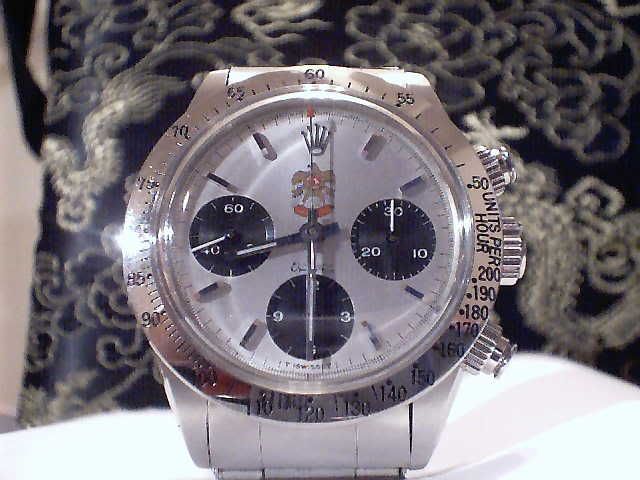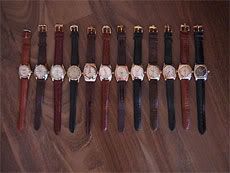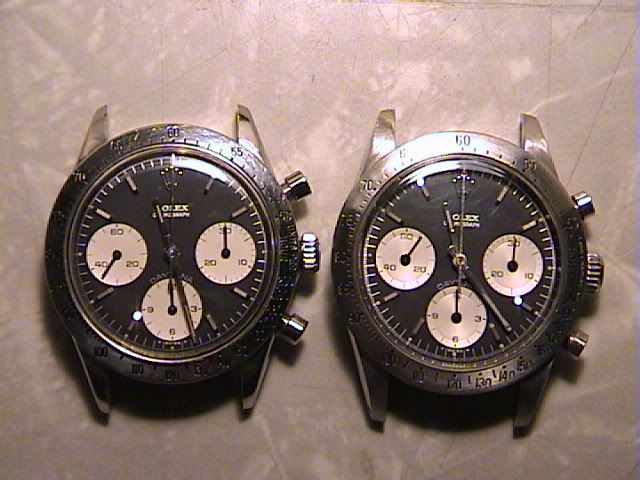
Please Visit Rolex.2itb.com http://www.horsyland.com https://photographic-experience.blogspot.hk/
Friday, June 23, 2006
Rolex vintage sports model daytona
 Rolex 6265 (with screw down crown and pushers)
Rolex 6265 (with screw down crown and pushers)Rare sports model made for the middle East market (with the Middle East Eagle icon on the dial). This watch is unique as Rolex no longer allows co-branding in its watch dial.
The daytona model has been popularised by Paul newmen in the movie. The early daytona uses non-Rolex movement and they are manual movements (Valjour).
Vintage Rolex moonphase

Rolex don't make any more moonphase watches. Since the late 1950s
These were the early so called "complicated" movement with day, date, time, moonphase, chronograph functions all into one at that time!
The 6062 Moonphase watch and the questionable 81806..
Please see:
http://www.interwatches.com/rolex-dials-history
Rolex Prince - a watch for those men, who were looking for something distinct to wear.
The Rolex Prince is One of THE classic!
During the 1930s, the price of the Rolex Prince is equivalent to the price of a car! It is widely known as a doctor's watch as it has a large separate subsidiary second dial for ease of reading for doctors when measuring the pulse rates of the patients. Rolex has recently re-launed a new Prince series but the feel of the watch is different (Please see enclosed photo).
Like the bubblebacks, the Rolex Prince comes in many variations, steel, gold (9k, 14k, 18k), silver, gold and steel, tiger straps etc. The Gruen doctor's watch and the Rolex Prince shared the same movements as the former were made for the US market while the latter were made for the rest of the world. They were not sold as competitors. However, the price of the Gruen is 30% of that of a Rolex. That's the power of brand building!
Rolex Prince - Watch History
The Rolex Prince has its place in watch making history as being one of the most groundbreaking watches released. Rolex released this watch in 1928 and its accuracy and ease of use set the standard for luxury watches. The Rolex Prince featured a stylish rectangular shape as well as two easily legible dials. Hours and minutes were tracked by the larger dial on top and seconds were counted on the smaller dial on bottom.
On initial release, the prince was available in two case styles, one was a more rectangular case (Classic) and the other was a much rounder design (Brancard), the choice of materials was yellow gold, sterling silver, platinum, and two tone combinations (steel was available later on). Brancard model watches were designated model 971 and Classic watches were model 1343. Shortly after its release, the Rolex Prince was augmented with a self winding movement, which eliminated the need for winding.
The “Railway Prince” was released in 1935 and was designed after the look of locomotives, this model was designated 1527. Rolex then introduced a new movement which was nicknamed “Jumping Hours”. This design would only feature minute markings on the larger top dial, with a slot open at the top (12 o’clock position) with a number display (1-12 Hours). As the minute hand swung past the hour display, the number would switch over to the next hour. This would also serve as the inspiration for the Rolex Datejust down the line.
One of the last models of the Rolex Prince was the “Super Precision Aerodynamic” version. It featured a singular large dial where the hour, minutes, and second hands all lived. The Rolex Prince line would be discontinued sometime in the 1940’s and replaced with the more circular and sporty designs.
Special Edition Rolex Prince Watches
Throughout its production period, the Rolex Prince watch has had numerous production runs as special editions. The “Sporting Prince” was a pocket watch that was designed to be used while engaged in athletic activities. It was contained in a case that would activate a spring mechanism that would present the dial to the user by popping out and tilting.
A large Canadian department store commissioned Rolex to create special edition versions of the Prince to give employees that have worked for more than 25 years, appropriately named the “Quarter Century Club”. These watches had the words “1/4 Century Club” printed on the edges of the hour and minutes dial instead of number markings.
Rolex bubbleback
Some background History from the web: Rolex was founded in
London, in 1905, by the 24-year-old Wilsdorf, a German who became a British
citizen after taking an English bride. It was an era when national borders
tended to define men's ambitions, but Wilsdorf thought big from the beginning.
In 1908, before anyone had uttered the term multinational, Wilsdorf trademarked
the word Rolex, a name that's easily pronounced in different languages and
short enough to fit on a watch dial. It's said that Wilsdorf dreamed up the
word while riding a London bus, having been inspired by the sound a watch makes
as it is wound
I love the Rolex bubblebacks! One of my key collections are
the vintage Rolex Bubbleback as these are the first fully functional automatic
watches produced in the 1930s. What attracts me was its unique protruding
backcase (which is why it was called bubbleback). One of the more unique Rolex watches is the
Rolex Bubbleback, whose name comes from its protruding case back, which bulges
in order to accommodate the thick movement and rotor that turns on a pivot,
powering the winding of the mainspring.
The first Bubbleback made its appearance in 1933, and the
watches were produced for only about twenty years. The Bubbleback helped
establish Rolex as a brand known for its reliability, and these watches
certainly are reliable—as evidenced by the relatively high number still
functioning today. Most of the early small and medium size Bubblebacks
displayed time only. The original model featured subsidiary seconds, which later
changed to sweeping seconds. Later
models also included the date, becoming the first DateJust models produced by
Rolex. In 1935, Rolex developed the “Super Balance,” a streamlined balance
wheel that improved the functioning of the Auto-Rotor. Rolex then began
producing the watch in three different sizes to make it more appealing to
individuals of both genders. In 1941, Rolex launched a Bubbleback model
intended specifically for ladies.
The Rolex Bubbleback is a very iconic watch, and a coveted
collector’s piece. There are many versions namely: in steel, half gold, gold
(9k, 14k, 18k Pink or Yellow gold) and hooded version as well as the varies
sizes and dials. One of the rare ones that I have is the one with the hooded
bubbleback in pink gold (made for the USA market) as well as the one with 9
Rolex crowns, and the California dial! www.rolex.2itb.com
Some additional information from the net. The bubbleback was
Launched in 1933, it was also one of the early Rolex models. The creation of
this model was a significant event for Rolex because it featured the first
Auto-Rotor. Rolex is not the first to create the automatic movement. Harwood
was one of the pionner. However, The Auto-Rotor signified Rolex's success in
developing a self-winding movement and what differntiates it from the
competitors was its reliability. Today, the Bubbleback is one of the most sought
after and collectible wristwatches in the world because production was
discontinued in the early 1960s.
How Did Rolex Succeed in Creating the Bubbleback?
In the 1920s, numerous watch-making companies were trying to
create a self-winding movement. They kept attempting to incorporate slight
modifications to Harwood's self-winding watch that featured a no winding stem.
However, Rolex was following altogether a different path. It experimented with
its existing movements and looked for a new solution to the old challenge.
Finally, in 1931, Rolex created the Auto-Rotor movement from an existing Aegler
movement (subsidiary seconds Hunter 8-3/4"). This invention resulted in a
"perpetual motion" wherein the winding mass could turn smoothly both
clockwise and counter-clockwise and pivot a full 360 degrees on its staff in
the center of the movement. In 1932, Rolex patented its first successful
self-winding perpetual wristwatch. One year later, the Rolex Bubbleback was
introduced into the market. Due to unsuccessful attempts in the past and the
resulting skepticism in the public eye, Rolex tried to publicize this new model
as "the watch sensation of 1934".
How the name Bubbleback come about?
The fascinating historical marker is the watch never had
"Bubbleback" engraved anywhere on it, and was never officially
designated that title as it was a term coined by the watch collectors. Instead,
it bore "Rolex Oyster Perpetual" just below the 12 o'clock position.
How did it come to be known as "Bubbleback?" The answer lies in its
bubble-shaped, thicker case back. The thick Auto-Rotor led to an over-sized
mechanism which needed a thicker case. Another nickname for this model had been
"Ovettone," an Italian word meaning "little egg." for the
Hong Konger, it was known as the "Little coffin" 倌材仔.
Notable Changes Introduced Over Time
The first Rolex Bubbleback was the model 1858 powered by the
Ref.520 movement. The sweep versions were powered by the Ref.530 movement. The
earliest Bubbleback models featured a 3-piece case and a deeper case back. In
1936, Rolex rolled out two new models: 3131 and 3132. Both these models sported
a new 2-piece case and new modified movement 9-3/4". The only difference
between the models was that while the Model 3131 was powered by the Ref.620
(subsidiary seconds), model 3132 was powered by the Ref.630 (sweep seconds). It
is interesting to note that the early Bubbleback watches were the first Rolex
models to be made available in the stainless steel material known as Steelium.
Some models were also made available in Rolesor (steel and gold combination).
The two terms, Steelium and Rolesor, were coined by Rolex and subsequently
patented in 1931 and 1933, respectively.
A significant breakthrough took place in 1935 when the
Bubbleback models were equipped with a new streamlined balance wheel known as
the "Super Balance." This improved the functioning of the Auto-Rotor.
Rolex went one step further by marketing its Bubbleback models in three sizes
so that they could appeal to men and women alike. In 1941, a ladies Bubbleback
model was launched, powered by the Ref.420 movement. However, no sweep version
of the model was made available for ladies. Later, in the 1950s, some
Bubbleback models--such as model 5018--were introduced featuring "Bombe
lugs".
Many other modifications, cosmetically as well as
technically, were introduced over time, finally leading to the development of a
new Rolex model called the"Big Bubbleback”. The Big Bubbleback led
directly to the development of the Rolex Datejust, which eventually became one
of the flagship Rolex models.
Vintage watches

I love watches! Especially vintage watches!
I have been collecting vintage watches since 1988~~
I started collecting watches when I was still in the university. I would source for T shirts from the factory and then sell them in University to earn money for the building of my vintage watch collection.
the 1980s-90s were the peak of the vintage watch collection. After 1997 the financial crisis, the fever for vintage watch collection seemed to cool down. Following which, many began to collect the newly produced watch instead of the vintage one owing to easy availability and ease of purchase.
Nevertheless, vintage watches remain my true love!
Subscribe to:
Comments (Atom)
Problem with signing in
I am facing issues with saving my blog with photos and I cannot seemed to log on using my ipad. Perhaps, the days have pme to end the blog....
-
2019 is going to be a good year as I have managed to find a nice 42mm Droz super compressor from Stockholm Sweden. Droz R.A.N. (Royal Austra...
-
According to Horological Journal January 2004, there are a few versions of IWC Mark XI. My guess is that there are more than 4 versions. E...
-
淺談大mm由來 大mm乃坊間對精工潛水錶形號SBDX001的別稱,緣於錶面上印有MARINEMASTER字様, 乃精工首枚潛水錶被冠以MARINEMASTER之名,之後的新一代吞拿也相繼加上同樣的字在錶面上. 大mm 原祖乃形號6215,要追索到1967年。精工首枚潛水錶,擁有...











.jpg)

